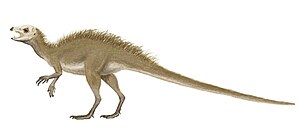Fruitadens
| Fruitadens | ||||||||
|---|---|---|---|---|---|---|---|---|

Live image of Fruitadens , reconstruction with feather-like skin structures on the back analogous to the related genus Tianyulong . |
||||||||
| Temporal occurrence | ||||||||
| Upper Jurassic (late Kimmeridgian to early Tithonian ) | ||||||||
| 154.7 to 147.7 million years | ||||||||
| Locations | ||||||||
|
||||||||
| Systematics | ||||||||
|
||||||||
| Scientific name | ||||||||
| Fruitadens | ||||||||
| Butler et al. , 2009 | ||||||||
| Art | ||||||||
|
Fruitadens is a genus of dinosaurs from the Heterodontosauridae group thatlived in North Americaduring the Upper Jurassic (Late Kimmeridgian to Early Tithonian ). Fossils were found in the 1970s, but were notscientifically described until 2009 by paleontologists working with Richard Butler . Fruitadens was one of the smallest non-avian dinosaurs known. The only known species is Fruitadens haagarorum .
features
According to Butler and colleagues, Fruitadens was the smallest pelvic dinosaur known to date . The largest specimens found are estimated to be 65 to 75 centimeters in length and 500 to 750 grams in weight. These specimens belonged to almost fully grown animals that were about five years old when they died. Like all representatives of this group, Fruitadens had different types of teeth ( heterodontics ) - an enlarged, canine-like tooth was found in the lower jaw , which fit into a hollow in the upper jaw. In the upper jaw, an enlarged canine tooth was missing, unlike the related Echinodon . Unique among ornithicians was a small tooth just in front of the enlarged canine of the lower jaw, which was longer than it was high. The crowns of the remaining teeth were low and triangular.
Way of life
Like its relatives, Fruitadens was adapted to running, the lower part of the hind leg was elongated. His diet was probably omnivorous , as indicated by the shape and degree of wear of the teeth. Adaptations to a vegetable diet were less well developed than in the case of Heterodontosaurus , for which some researchers also suspect an optional omnivory.
Systematics
Fruitadens is one of the Heterodontosauridae , a group of small, primitive Ornithischia. The relationships within this group are little known due to the incomplete fossil record. Butler and colleagues suspect that Fruitadens was more closely related to Heterodontosaurus tucki than to Echinodon becklesii . The following cladogram shows the possible position of Fruitadens within the Heterodontosauridae (after Butler, 2009):
| Heterodontosauridae |
|
||||||||||||||||||
|
|
Site and naming
Fruitadens fossils were recovered from the strata of the Morrison Formation (Brushy Basin limb), an important fossil deposit , by staff at the Natural History Museum of Los Angeles County . The location is northwest of Grand Junction , Colorado .
So far, the fossil remains of four individuals have been found: The holotype specimen (specimen number LACM 115747) consists of complete upper and lower jaws, some vertebrae (cervical, back, sacrum and tail vertebrae) and parts of a hind leg. A second specimen (specimen number LACM 115727) consists of vertebrae and parts of the hind legs, while two other specimens originating from young animals (specimen numbers LACM 128258 and LACM 120478) consist of pines, some vertebrae and parts of the front and rear legs.
The name Fruitadens indicates a discovery area in Colorado named after the town of Fruita , in which the fossils were discovered; the ending dens is Latin for "tooth". The Artepitheth haagorum honors Paul Haaga, Paul Haaga Jr., Heather Haaga, Blythe Haaga, Paul Haaga III and Catalina Haaga, who support the Natural History Museum of Los Angeles County decisively.
Individual evidence
- ^ Gregory S. Paul : The Princeton Field Guide To Dinosaurs. Princeton University Press, Princeton NJ et al. 2010, p. 240, ISBN 978-0-691-13720-9 , online .
- ↑ Dino sprinter weighed less than a kilo. In: Scinexx. Retrieved September 12, 2014 .
- ↑ a b c d e Richard J. Butler, Peter M. Galton , Laura B. Porro, Luis M. Chiappe , Donald M. Henderson, Gregory M. Erickson: Lower limits of ornithischian dinosaur body size inferred from a new Upper Jurassic heterodontosaurid from North America. In: Proceedings of the Royal Society. Series B: Biological Sciences. Vol. 277, No. 1680, 2010, ISSN 0080-4649 , pp. 375-381, doi : 10.1098 / rspb.2009.1494 .

